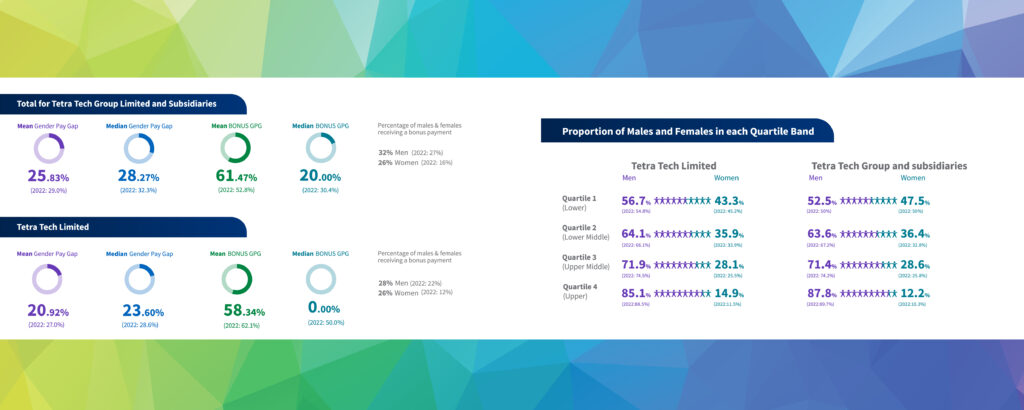Gender Pay Gap Reporting 2024

Tetra Tech’s annual Gender Pay Gap (GPG) report has officially been released today (28 March 2024). Our Gender Pay Gap results are based on the snapshot date of 5 April 2023.
Reporting our Gender Pay Gap
We are required to publish data for any legal entity where we have more than 250 employees. Currently, this only includes Tetra Tech Limited. However, for transparency, we have also shared the combined figures for all legal entities that currently sit under Tetra Tech Group Limited in the UK.
Notes regarding the way in which our 2024 figures are calculated can be found at the end of this article.
Diversity at Tetra Tech
Tetra Tech firmly believes a diverse range of perspectives, insights, and life experiences enrichens businesses and fosters innovative solutions to the world’s issues. Encouraging more women, and other underrepresented groups, to pursue a career in STEM is an integral part of benefiting society today, tomorrow, and beyond.
Whilst we appreciate there is always room for improvement, we understand that implementing true change is a long-term commitment that requires a combination of internal and external initiatives. We set ourselves challenging targets for diversity, equity, and inclusion; targets against which we continue to make progress.
Tetra Tech is pleased to see improvements from last year in Quartile 1 and 2, but more effort is needed to close the gap in the upper quartiles. One positive improvement has been our Senior Leadership Team, which is now 40% female, and a testament to the great work our female colleagues are doing.
We have also appointed a dedicated Diversity, Equity, and Inclusion Lead to further support our efforts. These efforts include reporting on our gender pay gap quarterly to ensure we are making progress against our targets, as well as monitoring data regarding our:
- Disability pay gap trends
- Ethnicity pay gap trends
- Compliance with our Diversity in Recruitment pledge
- Overall improvements in diversity, equity, and inclusion metrics
Internal Insights, Educational Sessions, and Accountability
Our diversity efforts work in tandem with our gender equality employee resource group. This group continually drives initiatives and offers educational awareness support through resource toolkits, challenging unintentional bias, and celebrating the achievements of our female colleagues. In 2024 they are particularly focusing on menopause awareness and training.
These insights are bolstered by regular expert speaker sessions, like Chair and Co-founder of the Association for Black and Minority Ethnic Engineers (AFBE-UK), Dr. Nike Folayan MBE, who spoke on understanding barriers to recruitment and retention for diverse groups. Tetra Tech has been a proud member of the AFBE for some years, supporting increased recruitment and retention of BME engineers.
We also heard from Tanya Wilkins, one of the highest ranking black female police officers in the North of England, who shared her experiences creating a more inclusive police force environment.
Through this combination of work, education, and accountability, we are continuing to break down barriers for the benefit of future generations of women, and our current female team members.
Recruitment, Retention, and Senior Leadership
Empowering current and future generations of underrepresented talent in STEM requires dedicated time and effort. We are committed to doing just that. For the 2023 New Civil Engineer (NCE) Awards, we were shortlisted for 7 categories, including the category of Equality, Diversity, and Inclusion Leader as an organisation.
This long-term dedication to recruitment continued with Tetra Tech being a major sponsor and consultant for several events during Northern Ireland’s Engineers Week 2024. Our team members spent the week visiting multiple schools, sparking the imaginations of hundreds of girls in the hopes of them pursuing a future career in STEM.
All of our efforts in these areas mean that, since July 2023, the majority of our new starters are from traditionally under-represented groups, and we see our overall diversity continue to improve.
Leading by example, Tetra Tech’s Division President, Craig Hatch, was added to the Northern Power Women Advocacy List this year. Craig’s commitment to DEI mentorship and coaching established him as one of the key male allies actively implementing change, as well as his continued support and association with WiN (Women in Nuclear).
In addition to Craig’s DEI mentorship, Tetra Tech’s internal Gender Equality Group is supported by the many DEI communities, both locally and globally:
-
The Racial Equality Group
Ensuring education, support, and conversations about race and ethnicity for the benefit of our internal workplace culture and recruitment.
-
The LGBTQ+ Group
Providing internal education on LGBTQ+ issues, celebrating our LGBTQ+ team members, and ensuring all feel welcome and supported at Tetra Tech.
-
The Disability Group
Raising awareness of the obstacles disabled and neurodivergent people face, challenging unconscious bias, and helping Tetra Tech make all business operations and communications more accessible.
These collective efforts and improvements will continue to reduce any unequitable obstacles. We believe that identifying what causes these barriers internally and externally is the key to ensuring the next decades of women and other underrepresented groups in STEM experience no barriers, only opportunities.
Notes on what is Being Reported and How is it Calculated
Gender Pay is not the same as Equal Pay. Equal pay is legally required and makes sure that both genders receive the same pay for doing the same (or equivalent) job.
Gender Pay is the comparison of the average hourly pay of men and the average hourly pay of women irrespective of the job they do, expressed as a percentage. We are legally required to share both a Median and Mean calculation.
Median: This is calculated by lining up the remuneration of male and female employees from highest to lowest. The median compares the female and the male in the middle of their lines.
Mean: This is the average of the whole sample for both men and women and therefore can be affected by extreme values at either end of the pay distribution.